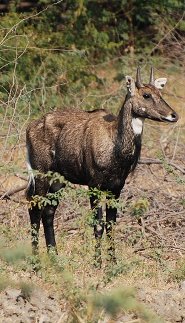Nilgai -- The Horse-like, Camel-like Antelope
 The Nilgai (Boselaphus tragocamelus) is a member of the bovine family, has a face similar to a horse, a camel hump-like area atop its broad shoulders, but is actually an antelope. The Nilgai is the largest Asian antelope and is native to India and Pakistan, where they number between 10,000 to 15,000. Tigers are their only natural predators, and the Nilgai prefer grasslands and bush lands to forested areas, so they are relatively safe there. The Nilgai is a bovine, so in many areas in India it is considered a sacred animal, and is therefore protected. Nilgai translates in Hindi to “blue cow,” and adult Nilgai bulls are actually a bluish-gray color. The cows and the calves are a light brownish-red color. Both sexes have white markings on parts of the head, chest, and belly, and a have a short raised mane on their neck. Bulls have horns that are 8-10 inches long (20-25cm) and a long tuft of hair hanging from the lower chest.
The Nilgai (Boselaphus tragocamelus) is a member of the bovine family, has a face similar to a horse, a camel hump-like area atop its broad shoulders, but is actually an antelope. The Nilgai is the largest Asian antelope and is native to India and Pakistan, where they number between 10,000 to 15,000. Tigers are their only natural predators, and the Nilgai prefer grasslands and bush lands to forested areas, so they are relatively safe there. The Nilgai is a bovine, so in many areas in India it is considered a sacred animal, and is therefore protected. Nilgai translates in Hindi to “blue cow,” and adult Nilgai bulls are actually a bluish-gray color. The cows and the calves are a light brownish-red color. Both sexes have white markings on parts of the head, chest, and belly, and a have a short raised mane on their neck. Bulls have horns that are 8-10 inches long (20-25cm) and a long tuft of hair hanging from the lower chest.Nilgai were imported to southern Texas, USA during the 1930s-1940s as game animals. Now they number close to 37,000 on ranches and in the wild. Since Nilgai are native to a different climate, an extremely cold winter in South Texas may kill many. However, they have no natural predators in Texas, so their numbers are increasing. Nilgai are hunted as game, and hunting ranches in South Texas will arrange guided hunts. Also, Nilgai meat and hide products are for sale at certain ranches in Texas, and through on-line sources.
The average size for a Nilgai is 180-200 cm (6-6.5 ft.), and weight is about 120-240kg (264-528 lb.), with the males being larger than the females. Calves weigh 13-16 kg (30-35 lb.) at birth. Mating takes place year round, but the peak is December-March. The bulls compete for the females in mating season by posturing, neck wrestling, and occasionally resort to fighting with their horns. Rarely, they fight to the death. Gestation period is 245 days (8 months), and females usually give birth to two calves. Family groups are composed of one male and several cows and calves with 4-20 animals per group. The Nilgai becomes sexually mature around 3-4 years of age and has a life span of 21 years.
In India and Texas, Nilgai compete with the cattle for food sources. They eat shoots, buds, flowers, fruit, and farmer’s crops when food is scarce. Some Indian farmers have built 6-7 ft. fences to prevent Nilgai from eating their crops, but since it is an antelope, it easily jumps these fences. The Nilgai is truly a remarkable as well as unusual looking animal.
Picture of the Nilgai by Thomas Schoch, licensed under the Creative Commons Attribution-Share Alike 3.0 Unported license and GFDL.
Tags used in this posting
Other entries about 'antelopes'
- Cape Grysbok - A Rarely Seen but Common South African Antelope
- Bongo - World's Largest Forest Antelope
- Indian rhinoceros - Rhino of the Asian riverscapes
- Even-toed ungulates (Artiodactyla)
Other entries about 'artiodactyla'
- Zebra Duiker - Fruit-cracking Specialist
- Greater Mouse Deer - Gives Peek at What Extinct Animals Were Like
- Roan Antelope - Goat- and Horse-like Antelope of Africa
- Musk Ox - Ice Age Survivor
- Sable Antelope - Scythe-horned Beauty
- Bongo - World's Largest Forest Antelope
- Addax
- Giraffe - The long-necked gourmet of the savanna
- Even-toed ungulates (Artiodactyla)
Other entries about 'asia'
- Javan langur -- The Monkey With a Mane
- Doria's tree-kangaroo
- Douc Langur - Endangered Colorful Asian Monkey
- Banded Hare-wallaby - Endangered Marsupial Nearly Wiped Out By Cats
- European Snow Vole - Vole with the Smallest Litters
- The Northern Chinese Flying Squirrel - The Squirrel with the Medicinal Dung
- White-throated Rock-thrush - the Little Snail-Cracker
- Daurian Hedgehog - Rare Russian Hedgehog Almost Wiped Out By Pesticides
- Greater Mouse Deer - Gives Peek at What Extinct Animals Were Like
- Kulan - Last Wild Donkey that Refuses to be Tamed
- The Japanese Macaque - Hot Springs-Loving Similian
- The Lion-Tailed Macaque - A Crying Old Man
- The Tibetan Fox - Silent Stalker of the Steppes
- Tiger - Largest cat killed by Chinese medicine?
- Puma - America's allrounder
- Proboscis monkey - The swimming star with the giant nose
- Lynx
- Indian rhinoceros - Rhino of the Asian riverscapes
Add your thoughts about this animal:
